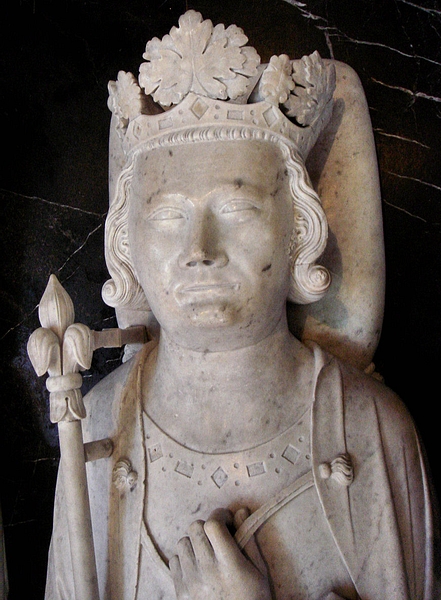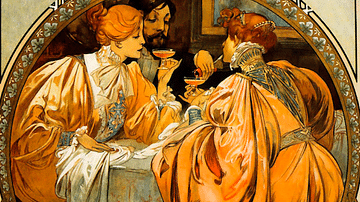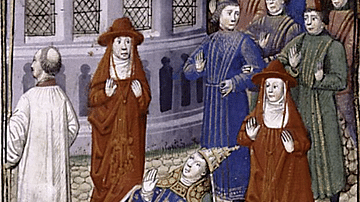
Joan I of Navarre (1273-1305) served as queen of Navarre and countess of Champagne and Brie between 1274 and 1305. In 1285, she also became queen consort of France following her marriage to Philip IV of France (reign 1285-1314). Between 1289 and 1297, she had four children, three of whom would become kings of France while one became queen consort of England. In the last year of her life, Joan founded the college of Navarre at the University of Paris.
Joan I’s life is also notable for being the first of a long series of queens regnant of Navarre. Between 1274-1517, five women became queens of Navarre, more than anywhere else in Europe. Furthermore, Joan I established precedent for how Navarre would be ruled by her female descendents.
Early Life & Marriage
Joan I, also known as Jeanne or Juana, was born in January 1273 to King Henry I of Navarre (c. 1244-1274) and Blanche of Artois (1248-1302). Joan was a member of the house of Champagne and later inherited the counties of Champagne and Brie. A series of unfortunate events resulted in her ultimate ascension to queen of Navarre and countess of Champagne and Brie. In 1270, Henry I became king of Navarre following the death of his older brother, King Theobald II of Navarre (1238-1270) while on the eighth crusade. Shortly after this, Joan’s older brother, a baby boy named Theobald, died after falling from a castle window in 1273. With no precedent of female heiresses in Navarre, Joan was named heir only until a new male heir could be born. But before Henry I and Blanche of Artois could conceive another child, Henry I himself died on the 22nd of July, 1274. This series of untimely deaths concluded with Joan’s ascension to the throne as an infant in 1274.
As a minority claimant, Joan’s position was unsure. Neighboring kingdoms saw an opportunity for expanding their dominions through marriage or force. Notably, the Castilian, French, and English kings sought to intervene in Navarre. While in Gascony in 1273-74, King Edward I of England (reign 1272-1307) attempted to negotiate a marriage between Joan and his son. Fearing encroachment of power, Blanche of Artois instead sought refuge at the court of her first cousin, King Philip III of France (reign 1270-1285). The result of this was the 1275 Treaty of Orleans where Joan was officially betrothed to Philip III’s younger son, Philip (later Philip IV of France).
Joan spent the rest of her childhood in France. Indeed, after Blanche of Artois fled with Joan to the French court, Joan never again returned to Navarre. Instead, Navarre was taken into the protection of Philip III. Blanche of Artois acted as regent of Navarre, Champagne, and Brie alongside her new husband, the widower brother of Edward I of England, Edmund of Lancaster (1245-1296). After Joan reached her majority, and therefore was deemed old enough to rule her lands as her own, Blanche of Artois and Edmund of Lancaster were forced to concede their rule. In their place, a series of French governors ruled Navarre. Champagne and Brie were fortunate to receive more active governance from Joan, but were nonetheless encompassed into French rule.
At age eleven in 1284, Joan was deemed by Philip III to have reached her majority. As such, Joan and Philip were married on the 16th of August. Their marriage entered Navarre and France into a formal political union, and further entrenched Champagne and Brie into French dominion. Philip IV (as he became the following year) and Joan’s marriage is largely believed to have been a successful one and produced seven children, four of whom lived until adulthood: Louis, Philip, Charles, and Isabella. Joan achieved the unique position of being the mother of four monarchs. Each of her sons would become kings of France and Isabella would marry King Edward II of England (reign 1307-1327) to become queen consort.
Queen of Navarre & France
Despite being queen regnant of Navarre, Joan never took much interest in its governance. Joan was never formally crowned in Navarre, and never visited, despite visiting Champagne and Brie. Joan was not criticized for her absence so much as Philip IV was: the Navarrese distrusted Philip IV’s motives. As king of France, the Navarrese suspected him of trying to intervene in another sovereign nation, and of trying to tie Navarre to France in perpetuity. Joan, however, left a lasting legacy on medieval Navarre in another way. As the first queen regnant of Navarre, Joan established a precedent of absentee rule for female monarchs. She was the first of five Navarrese queens regnant, all of whom ruled from afar as the wives of other European monarchs and nobles. Her legacy, therefore, was to attach Navarre in a despondent and unpopular relationship with France for the medieval era. Scholar of Navarrese queens, Elena Woodacre, describes Joan’s impact:
Juana I’s reign served as both a negative and positive model for later queens of Navarre and their consorts and it is clear that later agreements were shaped by the reign of the first queen and the actions of her consort.
Joan I also exerted limited political authority as queen consort of France. As queen consort, and not queen regnant, political power was designated to Philip IV. Joan’s attempts to influence French politics were not appreciated by Philip. When the people of Languedoc grew resentful of the French inquisition’s presence in the 1290’s, Joan took sympathy and accepted many expensive gifts of gratitude. Philip IV, however, ordered that she immediately return those gifts, thus halting her ability to act with political authority. In 1293, when war was brewing between England and France, King Edward I hoped that she might appease Philip, but she was again unsuccessful.
Joan, however, still took pride in her position. In the early years of her queenship, Joan I’s seal proudly contained the shields of Navarre and Champagne. Following the death of Philip III and her marriage to Philip IV, her seal was altered to reflect her position as queen of France. In Navarre, coinage from her reign reflected only her name, displaying allegiance to her as queen - and perhaps Navarrese resistance to French encroachment.
Countess of Champagne & Brie
Joan led Champagne through the particularly trying late 13th century, in which the economic prosperity and peace of Champagne and the Flemish low-country were wrecked. Throughout the 13th century, the geographic positioning of Champagne in relation to southern and northern Europe had established it as a stopping point for southern caravans. The Champagne fairs, which most famously sold textiles, were a lucrative and vital bordered county between France and Flanders. However, the attachment of Champagne in personal union to the French monarch frightened its neighbors. Rising tensions between England and France in the 1290s resulted in the marriage of Henry III of Bar (a bordering county to Champagne) to Eleanor Plantagenet, Edward I of England’s daughter. The alliance worsened the relationship between England and France, and secured Flemish protection from French advancement.
As tensions continued to brew, some looked to Joan to quell the atmosphere. In May of 1293, Joan’s stepfather, Edmund of Lancaster, alongside the earl of Lincoln, were sent to Paris to diffuse the situation. Joan attempted to assuage Philip IV and was initially successful. However, following the marriage of Henry III of Bar to Eleanor Plantagenet, as well as Edward I’s refusal to pay homage to Philip IV, war broke out. By 1294, both Edward I and Philip IV had rejected peace terms.
The subsequent wars ravaged Joan’s Champenois lands. The Franco-Flemish war, the Anglo-French war, as well as unrelated southern wars, effectively eliminated Champagne’s desirability as a stopping point for trade. The fairs, which sold French, Flemish, English, and textiles of other origins, suffered significantly. The financial demands of war resulted in Philip IV’s decision to tax the clergy, which necessarily drew the attention and indignation of the papacy. In 1299, following a papal bull, France and England signed the treaty of Montrieul. In this treaty, Joan’s only daughter, Isabella, was betrothed to the Prince of Wales. The treaty of Montrieul, however, failed in its object: war resumed between France and England. The wars had been detrimental to Joan’s lands. Subsequent wars, such as the Angevin-Aragonese war, further determined their fate. This, in combination with the discovery of new naval routes that bypassed France, resulted in the serious and ultimate failure of the Champagne fairs. What had, at the beginning of the 13th century, been a thriving industry, was in disrepair and abandonment by the beginning of the next century. At the end of Joan’s life, there was nothing that could be done to reinvigorate Champagne’s traditional economy.
All in all, Joan’s rule of Champagne was marked more so by her husband’s heavy-handedness in its governance. While Joan was the countess and had a say in its governance, it was really Philip IV that ruled Champagne.

Patronage
Perhaps Joan’s most famous act of patronage is the establishment of the college of Navarre at the university of Paris. Joan was the primary patron of the college, which provided a weekly allowance to students. The college’s initial aim was to provide a secular education to each new generation of the clergy. Following the rediscovery of classical thought in the crusades, the college of Navarre pioneered the cultivation of innovation in education. It taught combined methods of humanism and scholastic theology to its students. The college of Navarre lasted until 1793, when it was renamed L’Ecole Polytechnique. In Joan’s will, she stipulated that Philip IV would continue to provide fellowships to students of poorer backgrounds. However, Philip IV did not fulfil this wish. In the years after her death, the fellowships focused on more senior students who sometimes already held degrees.
Joan’s patronage also extended to literature. She is noted as the patron of Durand de Champagne, her Franciscan confessor. In 1300, Durand de Champagne completed the Speculum Dominarum, generally considered to be a biased book that represents Joan in a very positive light. Shortly before her death, Joan also commissioned Jean de Joinville to write a biography of Louis IX of France. Completed after her death in 1309, La Vie de Saint Louis provides first hand accounts from Joinville, who was a confidant of the king. It was dedicated to Joan I’s son, prince Louis (later Louis X of France). It is considered a significant work in medieval French literature, contributing to the historical understanding of Louis IX.
Joan I was also a consistent benefactor of the church. Alongside Philip IV, Joan founded and funded many religious institutions. She helped establish the monastery of Santa Clara of Tudela, a chapel in the castle in Tafalla, and the monastery of La Oliva. Also detailed in her will were funds for a hospital at Chateau-Thierry. Future queens regnant of Navarre would continue Joan’s legacy of religious patronage.
Death & Legacy
Joan I died on the second of April 1305. The circumstances of her death are unsure, with some reports stating that she died in childbirth. In 1308, accusations were leveled at the bishop of Troyes, Guichard. He was arrested for allegedly using witchcraft to murder her, as well as for crafting poisons to kill her sons. The accusations, however, never resulted in a conviction and Guichard was transferred to the diocese of Bosnia in 1314.
Queen Joan is known to have drafted at least two wills in her lifetime. Her final will, dated to 25 March 1305, named Philip IV as her executor. It contained a stipulation that Philip and their eldest son, Louis, would make a solemn promise to faithfully execute her last wishes. However, by and large, these promises were broken. Scholar Elizabeth Brown describes Philip IV’s actions regarding Joan’s will:
Some legacies were carried out, but little was done to promote the hospital at Chateau-Thierry and the college in Paris that Jeanne had established… During the years that followed Jeanne’s death, Philip indulged in an orgy of foundation and pious donation. To be sure, Jeanne’s name was often mentioned in the acts, but their nature suggests that Philip was engaging in intense competition with his dead wife, establishing foundations that were similar to hers, while neglecting her testamentary foundations.
Philip did, however, follow Joan’s desired burial plans. In 1304, Philip had petitioned the Pope for dispensation for Joan to have a divided burial (splitting one’s remains into many different portions to be buried in different lots). Joan rejected this. Instead, she elected to be buried whole in a Franciscan church in Paris. Her funeral was small and short but established precedent for future Navarrese queens to be buried outside of Navarre.









